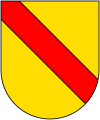Margraviate of Baden
|
Territory in the Holy Roman Empire |
|
|---|---|
| Margraviate of Baden | |
| coat of arms | |

|
|
| map | |
| Alternative names | Margraviate of Baden |
| Form of rule | county |
| Ruler / government | Margrave |
| Today's region / s | DE-BW |
| Parliament | 3 virile votes on the secular bench in the Reichsfürstenrat |
| Reichskreis | Swabian Empire |
| Capitals / residences | until 1535: Baden from 1771: Karlsruhe |
| Dynasties | House Baden |
| Denomination / Religions | until 1535: Roman Catholic from 1771: mixed Roman Catholic / Lutheran |
| Language / n |
German
|
| Incorporated into |
Electorate of Baden 1803
|
The Margraviate of Baden is a historical territory in the Holy Roman Empire of the German Nation. It was named as such in 1112 and existed until it was divided into the margraviate of Baden-Durlach and the margraviate of Baden-Baden in 1535 . In 1771 it revived with their reunification, until it became part of the Electorate in 1803 and in 1806 in the Grand Duchy of Baden . The ruling house of Baden was related to the Zähringen family .
history
Foundation and naming
The founder of the dynasty of the margraves of Baden was Hermann I (1052-1074), the elder son of Duke Berthold of Carinthia (1024-1078). His son Count Hermann II , Count im Breisgau , first called himself Margrave of Limburg , then in 1112 for the first time Margrave of Baden . He had acquired the area around Baden-Baden by balancing the Zähringer with the Staufers around the Duchy of Swabia and carried the title of margrave inherited from his father - originally that of the Verona march - in connection with the new center of power, the Hohenbaden Castle (old castle) in Baden-Baden .
Territory acquisitions
The original rulership center on the middle Neckar around Backnang , Besigheim and the newly acquired areas on the Upper Rhine could not be connected until 1219 through the acquisition of Pforzheim from the legacy of the Guelph Count Palatine Heinrich .
In the 12th and 13th centuries, the Baden partisans were the Staufer , between Backnang and Stuttgart , in the Karlsruhe area, in the northern Black Forest and in Breisgau the territorial expansion of the margraviate took place. The acquisition of half of the dominions of Lahr and Mahlberg in 1442 was important for the consolidation of the margraviate , creating a link between the southern part of Breisgau and the northern area around Baden-Baden. The late Middle Ages saw the expansion of Baden into a princely territorial state (administration, finances); Baden became an important territory between the Habsburg possessions in Breisgau and Ortenau and the Duchy of Württemberg .
The sidelines
From 1190 there was a Hachberg line , which was bought back by Margrave Bernhard I (1372–1431) in 1415 , but without the Sausenberg rule , which only fell to the Baden main line in 1503.
Division into two territories in 1535
In 1535, Baden was split into the territories of the Margraviate of Baden-Durlach (with Hachberg-Sausenberg) and the Margraviate of Baden-Baden .
Union of the sub-counties 1771
Margrave Karl Friedrich von Baden-Durlach inherited the Catholic line of Baden-Baden in 1771 and incorporated them into his rule. The residence was Karlsruhe , where Margrave Karl Wilhelm von Baden-Durlach had moved his residence in 1715. During Karl Friedrich's tenure, the area called Margraviate Baden from 1771 developed through an electorate (1803–1806) with significant territorial growth to form the Grand Duchy of Baden (1806–1918).
See also
- State of Baden
- Margraviate Baden-Hachberg
- List of the Margraves and Grand Dukes of Baden
- Family list of the House of Baden
- Baden's coat of arms
literature
- Annette Borchardt-Wenzel: Little history of bathing. Pustet, Regensburg 2011. ISBN 978-3-7917-2365-5 .
- Armin Kohnle : A short history of the margraviate of Baden. Leinfelden-Echterdingen 2007, ISBN 978-3-7650-8346-4 .
- Hansmartin Schwarzmaier : Baden. In: Meinrad Schaab , Hansmartin Schwarzmaier (ed.) U. a .: Handbook of Baden-Württemberg History . Volume 2: The Territories in the Old Kingdom. Edited on behalf of the Commission for Historical Regional Studies in Baden-Württemberg . Klett-Cotta, Stuttgart 1995, ISBN 3-608-91466-8 , pp. 164-246.
Web links
- Margraviate Baden in the Cosmographia Sebastian Munster
- Heraldry of the House of Baden
- Discover entry on geography online leo bw
- Heinz Krieg: A. Baden, Mgf.en von
- First Baden regional survey from 1761 to 1791 digitized map series at the Landesarchiv-BW, Generallandesarchiv Karlsruhe.
Remarks
- ↑ The margraviate of Hachberg as part of the margraviate of Baden-Durlach had its own vote, plus one vote each for the margravates of Baden-Baden and Baden-Durlach

